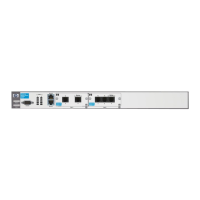6-68
Configuring the Data Link Layer Protocol for E1, T1, and Serial Interfaces
Troubleshooting Logical Interfaces
■ “Num Update Status Rcvd” indicates the number of full status reports the
interface has received. By default, the interface receives one full status
report every six polls, or one every 60 seconds.
■ “Num Status Timeouts” indicate the number of times the signal has been
lost. When the router misses three out of four polls, it takes down the
connection. When the interface continually sends out polls for which it
does not receive a reply, the link has a problem, such as:
• Signaling-type mismatch—Steadily incrementing status timeouts sig-
nal mismatched signaling-types. Check the signaling type listed in the
LMI statistics as “LMI Type” and verify that it matches that of the
service provider.
• DS0 channel mismatch—If you double-check your Data Link Layer
configurations but cannot discover what is causing the problem, you
may want to recheck the physical interface, even if its status is up.
Mismatched channels might not cause a problem until you attempt to
transmit data across a link. Use the show interface command for the
physical interface and check that you have dedicated the same num-
ber of channels to the carrier line as your service provider. Use the
tdm-group command to establish the correct number of channels for
the interface.
• DLCI error—If you have configured the wrong DLCI number for the
Frame Relay interface, the Frame Relay connection cannot be estab-
lished. Double-check the DLCI to ensure that you are using the correct
setting.
Displaying the PVC Status. You can view PVC statistics to monitor the
connection end-to-end and check for problems with traffic congestion and
dropped packets. From the enable mode context, enter:
ProCurve# show frame-relay pvc
The CLI displays information about each Frame Relay port, including how
many active, inactive, and deleted connections it has established. Table 6-14
shows possible PVC status terms and explains what each one means.

